Fluffy & Moist Coconut Cake Recipe
Are you eager to learn how to make a delicious coconut cake? Look no further! This step-by-step guide will walk you through the process of creating a mouthwatering coconut cake that will impress your friends and family. From preparing the batter to frosting the layers, we’ll cover everything you need to know to achieve coconut cake perfection. Get ready to indulge in the tropical flavors of coconut with this irresistible homemade cake recipe. Let’s dive in!
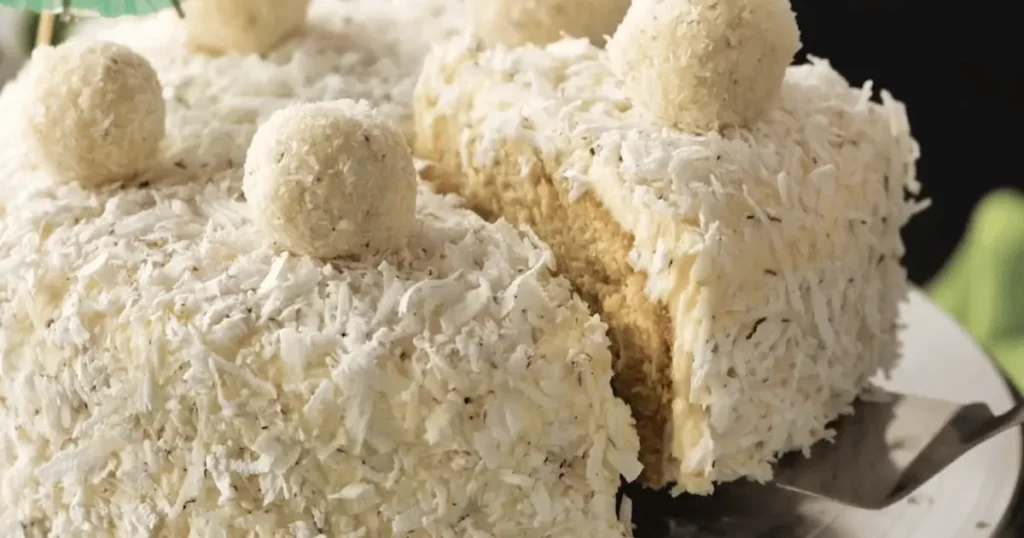
What Makes Moist Coconut Cake Recipe So great?
This recipe has a few special parts that make it really good.
First, instead of just using coconut flavoring, like coconut extract or essence, my recipe also uses coconut milk. This adds more coconut taste to the cake and makes it fluffy. Coconut milk makes the batter wetter and has a lot of fat, which makes the cake very soft.
Second, when making the batter, I mix the butter and sugar together first. This creates air bubbles in the mix, which makes the cake light and fluffy when it bakes.
Lastly, I add the dry ingredients slowly by hand at the end. This helps to not mix the batter too much, which can make the cake tough and heavy.
Ingredients To Make Coconut Cake
Butter – Incorporate salted butter into both the cake layers and frosting to infuse vital fats and elevate the overall taste.
Oil – By blending oil and butter in my baking, I capture the ultimate combination of moistness and flavor in the cake. This method is my go-to for ensuring the cake stays delightfully moist.
Sugar – Using white granulated sugar ensures the cake layers are sweetened to perfection.
Eggs – A combination of whole eggs and egg whites gives a fluffy texture, richness, and lovely light color to the cake.
Vanilla Extract – Although vanilla extract isn’t the dominant flavor, its addition harmonizes the other tastes beautifully. Trying your hand at making Homemade Vanilla Extract can be a game-changer for both the cake layers and frosting.
Coconut Extract – To boost the coconut taste in both the cake layers and frosting, I used just a hint of it, careful not to overshadow the natural coconut essence.
Flour – In my experience, cake flour yields the best results for this recipe. However, if you find yourself in a bind, all-purpose flour can also be used. While the texture may not be as delicate and light, it’s still a close second in terms of quality.
Baking Powder – A flawless rising agent for achieving a wonderfully fluffy and light cake crumb.
Salt – To elevate the flavors of the cake, consider adding a touch more salt to both the cake layers and frosting, especially if you’re using unsalted butter.
Coconut Milk – To achieve the desired consistency in both the cake batter and frosting, coconut milk is essential. While you can substitute regular milk or heavy cream, doing so may diminish some of the extra coconut flavor.
Shuddered Sweetened Coconut – This shredded sweetened coconut steals the spotlight, providing a chewy texture on the outside along with a delightful tropical flavor!
Cream Cheese – As the foundation of the coconut cream cheese frosting, this ingredient’s tanginess complements the sweetness of the other cake components perfectly.
Powdered Sugar – To sweeten the frosting and give it some substance.
How To Make Best Coconut Cake
To start baking your delicious coconut cake, begin by preheating your oven to 160°C (320°F) with the fan on. If your oven doesn’t have a fan option, adjust the temperature to 175°C/350°F for optimal baking. Don’t forget to grease two 8-inch cake pans and line the bottoms with parchment paper to prevent sticking. This step is crucial as coconut cake layers tend to adhere to the pan. Using homemade cake release adds an extra layer of assurance. Follow these simple steps to ensure your coconut cake comes out perfectly every time!

In a mixing bowl, combine all-purpose flour, cornstarch, baking powder, and salt. Sift the dry ingredients together to ensure a smooth texture. Use a whisk or fork to thoroughly blend the mixture. This step is crucial for evenly distributing the leavening agents and achieving the perfect balance of flavors. Once combined, set the dry ingredients aside for later use in your recipe.

In a separate mixing bowl, combine butter, vegetable oil, and sugar. Utilize an electric mixer—both hand and stand mixers work perfectly fine—to cream the ingredients together for approximately 2 minutes, or until the mixture becomes lighter in color. This crucial step ensures a smooth and fluffy texture for your cake batter.

Gradually add eggs one at a time, ensuring thorough mixing between each addition (approximately 10-15 seconds per egg). Remember to scrape down the sides of the bowl as needed to incorporate all ingredients evenly.
Next, introduce vanilla extract/essence and coconut essence/extract, along with half a cup of coconut milk, ensuring thorough blending for a harmonious flavor profile. Transition to hand mixing for the remainder of the batter, ensuring a smooth and consistent texture.

Incorporate half of the pre-mixed dry ingredients into the wet mixture, folding gently with a spatula to achieve a barely combined consistency. Next, blend in the additional 3/4 cup of coconut milk, ensuring to fold carefully until evenly integrated. Conclude by adding the rest of the dry ingredients, folding them in delicately to maintain a light texture without overmixing (refer to note 6 in the recipe below for guidance). This method ensures your bake is moist and fluffy, perfect for those seeking to master the art of baking.
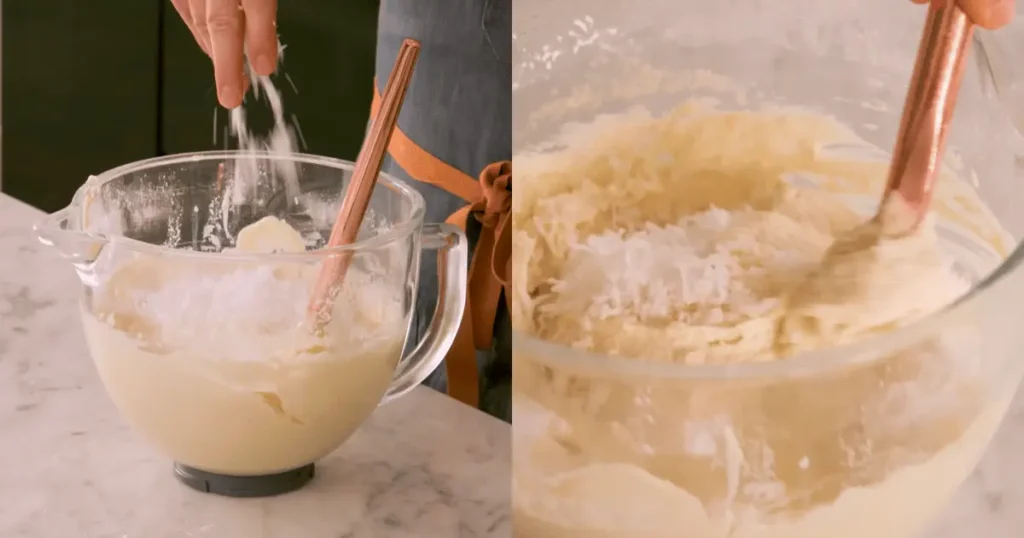
Lastly, sprinkle in the shredded coconut and delicately fold it into the mixture using a spatula until evenly distributed. Be careful not to overmix the batter, as this can affect the final texture of your dish.
Divide the batter evenly between the two 8-inch cake pans, ensuring a smooth distribution. Place them in the oven and bake for approximately 33 minutes, or until a toothpick inserted into the center comes out clean.
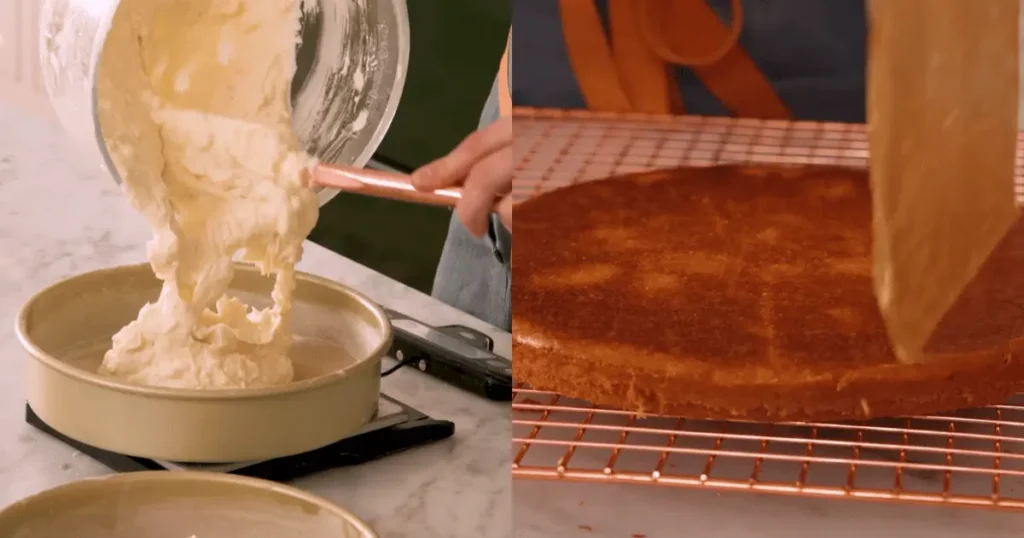
After baking, let the cake layers cool inside the pans for roughly 15-20 minutes. Then, carefully transfer them onto a wire rack to cool completely before frosting. Once cooled, you can apply the delicious coconut cream cheese frosting using the recipe provided below.
How To Make Coconut Cream Cheese Frosting
To achieve a light and fluffy consistency, cream the butter for a few minutes. You can use either a hand mixer or a stand mixer set to medium-high speed. If using a stand mixer, attach the paddle attachment for optimal results.
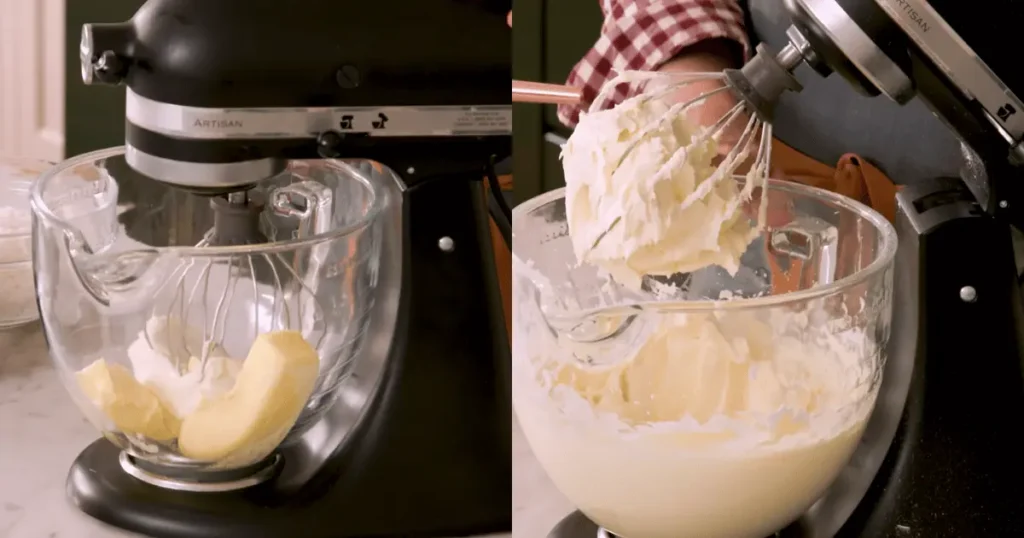
Gradually incorporate the icing sugar into the butter mixture in three separate batches, mixing on low speed. Make sure each batch of icing sugar is fully combined with the butter before adding the next one.
Then, add the cold cream cheese, vanilla extract, and coconut essence to the mixture. Mix until the frosting is smooth, being careful not to over-mix. Over-mixing can lead to a runny consistency.
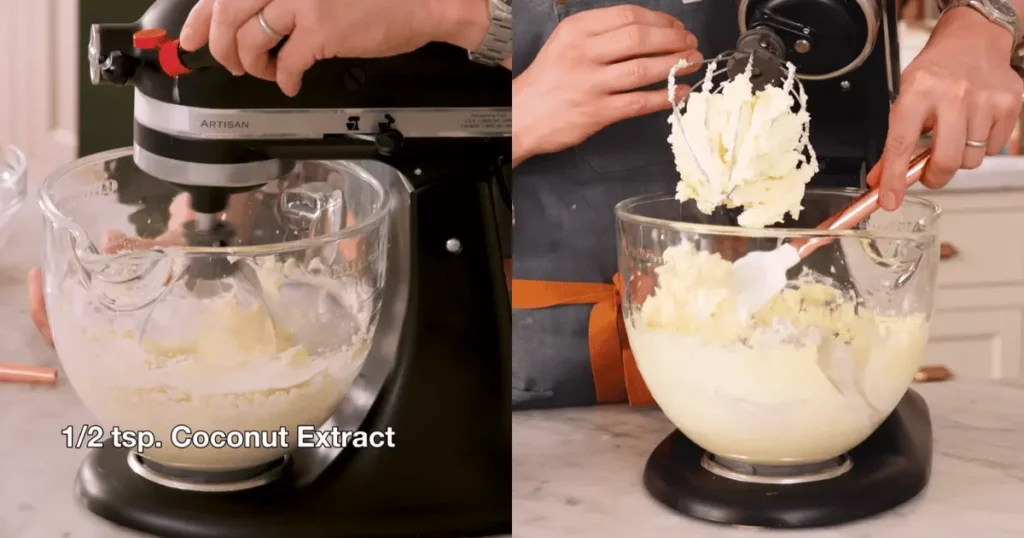
How To Decorate a Coconut Layer Cake
Firstly, I prefer trimming the caramelized edges of the cake layers, though this step is entirely optional and serves purely aesthetic purposes in my decorating process.
After trimming, generously apply frosting to the first cake layer and spread it evenly using an offset spatula or knife.

Position the next cake layer atop the first and generously spread frosting on the top and sides. Utilize a cake scraper to achieve smooth sides (see video demonstration).
Cover the top and sides of the cake with shredded coconut by gently pressing it into the frosting.
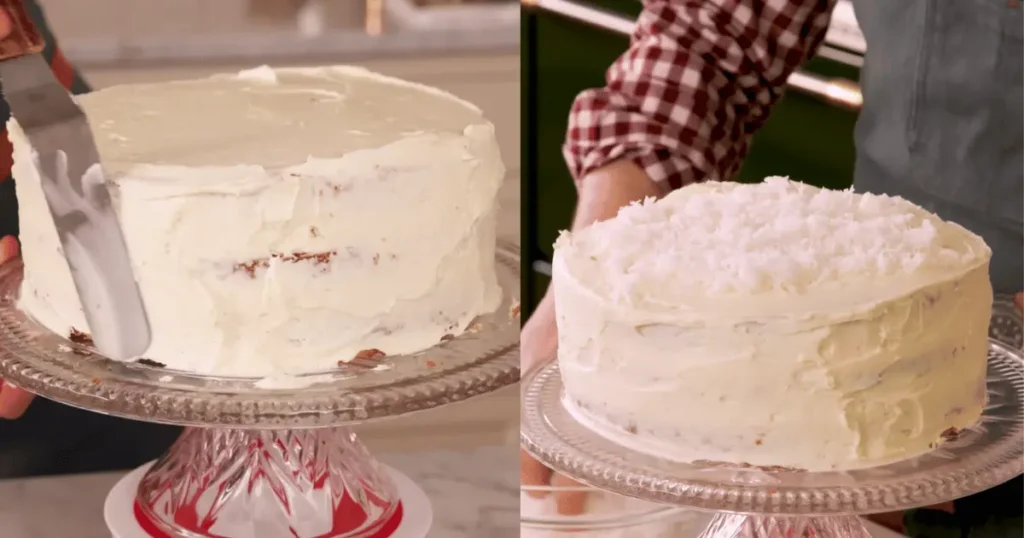
And there you have it! Your coconut cake is now ready to be served.
Commonly Asked Questions
More Classic Cake Recipes
Celebrate flavor with these moist classic cake recipes! Indulge in timeless favorites that never go out of style.
- Chocolate Cake
- Red Velvet Cake
- Pound Cake
- Lemon Blueberry Cake
- Strawberry Cake
Ingredients
Coconut Cake
- 1.13 cups (140 g) flour – regular, all purpose
- 0.13 cup (15 g) cornstarch – also known as cornflour
- 0.5 tbsp baking powder
- 0.25 tsp salt – omit if using salted butter
- 0.25 cup (56.5 g) unsalted butter – room temp
- 1.5 tbsp unflavoured vegetable oil – I use canola oil
- 0.83 cups (166 g) white granulated sugar
- 1.5 large eggs – room temperature
- 0.75 tsps vanilla essence/extract
- 0.5 tsp coconut essence/extract – can substitute with 1/2 tsp almond essence/extract (see note 1)
- 0.63 cups (137.5 g) canned coconut milk
- 0.5 cup (40 g) shredded coconut – dried, also called threaded coconut
Coconut Cream Cheese Frosting
- 0.5 cup (112.5 g) unsalted butter – room temperature
- 2.25 cups (285 g) icing sugar – also called powdered/confectioners sugar
- 0.75 cups (167.5 g) cream cheese – cold, firm type (see note 2)
- 0.75 tsps vanilla essence/extract
- 0.5 tsp coconut essence/extract – can substitute with 1/2 tsp almond essence/extract (see note 1)
- 0.75 cups (60 g) shredded coconut – dried, for decorating (recommended for texture – see note 8). Also called threaded coconut
Instructions
For the Coconut Cake
- Start by heating your oven to 160°C (320°F), activating the fan feature if available (refer to note 3 for alternatives without a fan function). Prepare two 8-inch-deep cake pans (about 3 inches deep) by greasing them and lining the bottoms with parchment paper (see note 4 for details).
- In a mixing bowl, sift the flour, cornstarch, baking powder, and salt together. Stir these dry ingredients until they’re perfectly blended and set them aside.
- In a separate, larger bowl, combine butter, vegetable oil, and sugar. Use an electric mixer (handheld or stand, as per note 5) to cream them together for about 2 minutes, until the mixture is visibly lighter.
- Introduce eggs one at a time, ensuring each is well incorporated before adding the next, with a brief 10-15 second pause between each.
- Stir in vanilla and coconut extracts, along with half a cup of coconut milk, blending everything smoothly. After this, you’ll switch to manual mixing.
- Incorporate half of your dry ingredients into the wet mix, folding gently with a spatula until just mixed. Add the remaining coconut milk, blend, then follow with the rest of the dry ingredients, folding just until combined without overmixing (important, see note 6).
- Fold in the shredded coconut last, being careful not to overwork the batter.
- Evenly distribute the batter between the prepared cake pans and bake for 33 minutes or until a toothpick inserted comes out clean. Allow the cakes to cool in their pans for 15-20 minutes before transferring them to a wire rack to cool completely. They’re now ready to be adorned with coconut cream cheese frosting as desired.
For the Coconut Cream Cheese Frosting
- Cream your butter for a few minutes until it achieves a light and fluffy texture. For this step, you can use either a hand mixer or a stand mixer sets to medium-high speed. If opting for a stand mixer, attach the paddle for best results.
- Gradually incorporate the icing sugar in three separate additions, mixing on a low speed to prevent dusting. Make sure each addition of icing sugar is fully blended with the butter before introducing the next, ensuring a smooth consistency.
- Then, introduce the cold cream cheese along with vanilla and coconut extracts into the mix. Continue mixing just until the frosting reaches a smooth texture, being mindful to stop before over-mixing to maintain the perfect consistency (refer to note 7 for more details).
Assembly
- If desired, you can start by trimming the caramelized edges from your cake layers to create a more uniform appearance, though this step is entirely optional.
- Next, apply a liberal amount of frosting to the first layer of your cake, using an offset spatula or a knife to evenly spread it. This creates a smooth and inviting layer of frosting that acts as both a glue and a flavor enhancer between the cake layers.
- After placing the second layer on top, cover both the top and sides with a generous layer of frosting. For achieving a professional-looking finish, employ a cake scraper to smooth the sides. Watching a video tutorial could provide visual guidance and techniques for this step (see video demonstration).
- Finally, envelop the cake in shredded coconut by gently pressing the coconut into the frosting all around the top and sides. This not only adds a delightful texture and flavor but also gives the cake an elegant, finished look.
Notes
Note 1: If coconut essence is hard to find, substitute 1 tsp of coconut essence with 1/2 tsp of almond essence. This swap slightly alters the coconut flavor but won’t significantly impact the overall taste.
Note 2: For frosting that holds its shape, especially in warm climates, use firm, cold cream cheese rather than spreadable varieties. If the frosting softens, chilling it for 30 minutes before rewhipping can restore its consistency, making it ideal for piping.
Note 3: Utilize the oven’s fan function to bake cakes more quickly. If your oven lacks this feature, increase the temperature to 175°C (347°F) to achieve similar baking results.
Note 4: To prevent cake layers from sticking to the pan, it’s crucial to line the bottom with baking paper, ensuring easy removal without damage.
Note 5: When using a stand mixer, start with the paddle attachment for mixing. For the final steps, switch to manual mixing to preserve the texture.
Note 6: Folding ingredients gently into the batter prevents excessive gluten development, resulting in a softer cake. Mix just until the batter is uniform and no flour streaks remain.
Note 7: Mix the frosting only until smooth to avoid overmixing. Overworked frosting can become runny due to the interaction of cream cheese liquid and icing sugar.
Note 8: Shredded coconut adds a delightful texture as an external cake decoration. Alternatively, for a subtler touch, fold shredded coconut into the frosting before applying it to the cake.
Nutrition
Calories: 672kcal | Carbohydrates: 114g | Protein: 10g | Fat: 43g | Saturated Fat: 28g | Polyunsaturated Fat: 3g | Monounsaturated Fat: 8g | Trans Fat: 1g | Cholesterol: 115mg | Sodium: 493mg | Potassium: 273mg | Fiber: 2g | Sugar: 41g | Vitamin A: 833IU | Vitamin C: 1mg | Calcium: 190mg | Iron: 2mg
The nutritional details provided are approximate estimates, calculated through an automated third-party application. The actual nutritional values may vary depending on the specific brands and types of products used.
Ingredients
Coconut Cake
- 2¼ cups (280 g) flour – regular, all purpose
- ¼ cup (30 g) cornstarch – also known as cornflour
- 1 tbsp baking powder
- ½ tsp salt – omit if using salted butter
- ½ cup (113 g) unsalted butter – room temp
- 3 tbsp unflavoured vegetable oil – I use canola oil
- 1⅔ cups (332 g) white granulated sugar
- 3 large eggs – room temperature
- 1½ tsps vanilla essence/extract
- 1 tsp coconut essence/extract – can substitute with 1/2 tsp almond essence/extract (see note 1)
- 1¼ cups (275 g) canned coconut milk
- 1 cup (80 g) shredded coconut – dried, also called threaded coconut
Coconut Cream Cheese Frosting
- 1 cup (225 g) unsalted butter – room temperature
- 4½ cups (570 g) icing sugar – also called powdered/confectioners sugar
- 1½ cups (335 g) cream cheese – cold, firm type (see note 2)
- 1½ tsps vanilla essence/extract
- 1 tsp coconut essence/extract – can substitute with 1/2 tsp almond essence/extract (see note 1)
- 1½ cups (120 g) shredded coconut – dried, for decorating (recommended for texture – see note 8). Also called threaded coconut
Instructions
Coconut Cake
- Start by heating your oven to 160°C (320°F), activating the fan feature if available (refer to note 3 for alternatives without a fan function). Prepare two 8-inch-deep cake pans (about 3 inches deep) by greasing them and lining the bottoms with parchment paper (see note 4 for details).
- In a mixing bowl, sift the flour, cornstarch, baking powder, and salt together. Stir these dry ingredients until they’re perfectly blended and set them aside.
- In a separate, larger bowl, combine butter, vegetable oil, and sugar. Use an electric mixer (handheld or stand, as per note 5) to cream them together for about 2 minutes, until the mixture is visibly lighter.
- Introduce eggs one at a time, ensuring each is well incorporated before adding the next, with a brief 10-15 second pause between each.
- Stir in vanilla and coconut extracts, along with half a cup of coconut milk, blending everything smoothly. After this, you’ll switch to manual mixing.
- Incorporate half of your dry ingredients into the wet mix, folding gently with a spatula until just mixed. Add the remaining coconut milk, blend, then follow with the rest of the dry ingredients, folding just until combined without overmixing (important, see note 6).
- Fold in the shredded coconut last, being careful not to overwork the batter.
- Evenly distribute the batter between the prepared cake pans and bake for 33 minutes or until a toothpick inserted comes out clean. Allow the cakes to cool in their pans for 15-20 minutes before transferring them to a wire rack to cool completely. They’re now ready to be adorned with coconut cream cheese frosting as desired.
Coconut Cream Cheese Frosting
- Cream your butter for a few minutes until it achieves a light and fluffy texture. For this step, you can use either a hand mixer or a stand mixer sets to medium-high speed. If opting for a stand mixer, attach the paddle for best results.
- Gradually incorporate the icing sugar in three separate additions, mixing on a low speed to prevent dusting. Make sure each addition of icing sugar is fully blended with the butter before introducing the next, ensuring a smooth consistency.
- Then, introduce the cold cream cheese along with vanilla and coconut extracts into the mix. Continue mixing just until the frosting reaches a smooth texture, being mindful to stop before over-mixing to maintain the perfect consistency (refer to note 7 for more details).
Assembly
- If desired, you can start by trimming the caramelized edges from your cake layers to create a more uniform appearance, though this step is entirely optional.
- Next, apply a liberal amount of frosting to the first layer of your cake, using an offset spatula or a knife to evenly spread it. This creates a smooth and inviting layer of frosting that acts as both a glue and a flavor enhancer between the cake layers.
- After placing the second layer on top, cover both the top and sides with a generous layer of frosting. For achieving a professional-looking finish, employ a cake scraper to smooth the sides. Watching a video tutorial could provide visual guidance and techniques for this step (see video demonstration).
- Finally, envelop the cake in shredded coconut by gently pressing the coconut into the frosting all around the top and sides. This not only adds a delightful texture and flavor but also gives the cake an elegant, finished look.
Notes
Note 1: If coconut essence is hard to find, substitute 1 tsp of coconut essence with 1/2 tsp of almond essence. This swap slightly alters the coconut flavor but won’t significantly impact the overall taste.
Note 2: For frosting that holds its shape, especially in warm climates, use firm, cold cream cheese rather than spreadable varieties. If the frosting softens, chilling it for 30 minutes before rewhipping can restore its consistency, making it ideal for piping.
Note 3: Utilize the oven’s fan function to bake cakes more quickly. If your oven lacks this feature, increase the temperature to 175°C (347°F) to achieve similar baking results.
Note 4: To prevent cake layers from sticking to the pan, it’s crucial to line the bottom with baking paper, ensuring easy removal without damage.
Note 5: When using a stand mixer, start with the paddle attachment for mixing. For the final steps, switch to manual mixing to preserve the texture.
Note 6: Folding ingredients gently into the batter prevents excessive gluten development, resulting in a softer cake. Mix just until the batter is uniform and no flour streaks remain.
Note 7: Mix the frosting only until smooth to avoid overmixing. Overworked frosting can become runny due to the interaction of cream cheese liquid and icing sugar.
Note 8: Shredded coconut adds a delightful texture as an external cake decoration. Alternatively, for a subtler touch, fold shredded coconut into the frosting before applying it to the cake.
Nutrition
Calories: 672kcal | Carbohydrates: 114g | Protein: 10g | Fat: 43g | Saturated Fat: 28g | Polyunsaturated Fat: 3g | Monounsaturated Fat: 8g | Trans Fat: 1g | Cholesterol: 115mg | Sodium: 493mg | Potassium: 273mg | Fiber: 2g | Sugar: 41g | Vitamin A: 833IU | Vitamin C: 1mg | Calcium: 190mg | Iron: 2mg
The nutritional details provided are approximate estimates, calculated through an automated third-party application. The actual nutritional values may vary depending on the specific brands and types of products used.
Ingredients
Coconut Cake
- 4.5 cups (560 g) flour – regular, all purpose
- 0.5 cup (60 g) cornstarch – also known as cornflour
- 2 tbsp baking powder
- 1 tsp salt – omit if using salted butter
- 1 cup (226 g) unsalted butter – room temp
- 6 tbsp unflavoured vegetable oil – I use canola oil
- 3.33 cups (664 g) white granulated sugar
- 6 large eggs – room temperature
- 3 tsps vanilla essence/extract
- 2 tsp coconut essence/extract – can substitute with 1/2 tsp almond essence/extract (see note 1)
- 2.5 cups (550 g) canned coconut milk
- 2 cup (160 g) shredded coconut – dried, also called threaded coconut
Coconut Cream Cheese Frosting
- 2 cup (450 g) unsalted butter – room temperature
- 9 cups (1140 g) icing sugar – also called powdered/confectioners sugar
- 3 cups (670 g) cream cheese – cold, firm type (see note 2)
- 3 tsps vanilla essence/extract
- 2 tsp coconut essence/extract – can substitute with 1/2 tsp almond essence/extract (see note 1)
- 3 cups (240 g) shredded coconut – dried, for decorating (recommended for texture – see note 8). Also called threaded coconut
Instructions
Coconut Cake
- Start by heating your oven to 160°C (320°F), activating the fan feature if available (refer to note 3 for alternatives without a fan function). Prepare two 8-inch-deep cake pans (about 3 inches deep) by greasing them and lining the bottoms with parchment paper (see note 4 for details).
- In a mixing bowl, sift the flour, cornstarch, baking powder, and salt together. Stir these dry ingredients until they’re perfectly blended and set them aside.
- In a separate, larger bowl, combine butter, vegetable oil, and sugar. Use an electric mixer (handheld or stand, as per note 5) to cream them together for about 2 minutes, until the mixture is visibly lighter.
- Introduce eggs one at a time, ensuring each is well incorporated before adding the next, with a brief 10-15 second pause between each.
- Stir in vanilla and coconut extracts, along with half a cup of coconut milk, blending everything smoothly. After this, you’ll switch to manual mixing.
- Incorporate half of your dry ingredients into the wet mix, folding gently with a spatula until just mixed. Add the remaining coconut milk, blend, then follow with the rest of the dry ingredients, folding just until combined without overmixing (important, see note 6).
- Fold in the shredded coconut last, being careful not to overwork the batter.
- Evenly distribute the batter between the prepared cake pans and bake for 33 minutes or until a toothpick inserted comes out clean. Allow the cakes to cool in their pans for 15-20 minutes before transferring them to a wire rack to cool completely. They’re now ready to be adorned with coconut cream cheese frosting as desired.
Coconut Cream Cheese Frosting
- Cream your butter for a few minutes until it achieves a light and fluffy texture. For this step, you can use either a hand mixer or a stand mixer sets to medium-high speed. If opting for a stand mixer, attach the paddle for best results.
- Gradually incorporate the icing sugar in three separate additions, mixing on a low speed to prevent dusting. Make sure each addition of icing sugar is fully blended with the butter before introducing the next, ensuring a smooth consistency.
- Then, introduce the cold cream cheese along with vanilla and coconut extracts into the mix. Continue mixing just until the frosting reaches a smooth texture, being mindful to stop before over-mixing to maintain the perfect consistency (refer to note 7 for more details).
Assembly
- If desired, you can start by trimming the caramelized edges from your cake layers to create a more uniform appearance, though this step is entirely optional.
- Next, apply a liberal amount of frosting to the first layer of your cake, using an offset spatula or a knife to evenly spread it. This creates a smooth and inviting layer of frosting that acts as both a glue and a flavor enhancer between the cake layers.
- After placing the second layer on top, cover both the top and sides with a generous layer of frosting. For achieving a professional-looking finish, employ a cake scraper to smooth the sides. Watching a video tutorial could provide visual guidance and techniques for this step (see video demonstration).
- Finally, envelop the cake in shredded coconut by gently pressing the coconut into the frosting all around the top and sides. This not only adds a delightful texture and flavor but also gives the cake an elegant, finished look.
Notes
Note 1: If coconut essence is hard to find, substitute 1 tsp of coconut essence with 1/2 tsp of almond essence. This swap slightly alters the coconut flavor but won’t significantly impact the overall taste.
Note 2: For frosting that holds its shape, especially in warm climates, use firm, cold cream cheese rather than spreadable varieties. If the frosting softens, chilling it for 30 minutes before rewhipping can restore its consistency, making it ideal for piping.
Note 3: Utilize the oven’s fan function to bake cakes more quickly. If your oven lacks this feature, increase the temperature to 175°C (347°F) to achieve similar baking results.
Note 4: To prevent cake layers from sticking to the pan, it’s crucial to line the bottom with baking paper, ensuring easy removal without damage.
Note 5: When using a stand mixer, start with the paddle attachment for mixing. For the final steps, switch to manual mixing to preserve the texture.
Note 6: Folding ingredients gently into the batter prevents excessive gluten development, resulting in a softer cake. Mix just until the batter is uniform and no flour streaks remain.
Note 7: Mix the frosting only until smooth to avoid overmixing. Overworked frosting can become runny due to the interaction of cream cheese liquid and icing sugar.
Note 8: Shredded coconut adds a delightful texture as an external cake decoration. Alternatively, for a subtler touch, fold shredded coconut into the frosting before applying it to the cake.
Nutrition
Calories: 672kcal | Carbohydrates: 114g | Protein: 10g | Fat: 43g | Saturated Fat: 28g | Polyunsaturated Fat: 3g | Monounsaturated Fat: 8g | Trans Fat: 1g | Cholesterol: 115mg | Sodium: 493mg | Potassium: 273mg | Fiber: 2g | Sugar: 41g | Vitamin A: 833IU | Vitamin C: 1mg | Calcium: 190mg | Iron: 2mg
The nutritional details provided are approximate estimates, calculated through an automated third-party application. The actual nutritional values may vary depending on the specific brands and types of products used.



